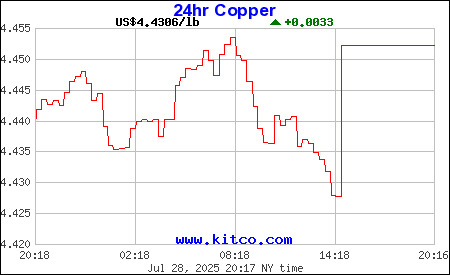It would be easy to assume the world was about to run out of copper.
The price of copper, a vital cog in the global economy found in almost every building and electrical circuit, has soared past previous records to hit $10,000 a tonne earlier this year. And predictions persist that it could rise above $13,000 by year end.
The increasingly apparent oversupply of copper in China, consumer of 40 per cent of the world’s supply, has made investors nervy. Prices are down $750 a tonne from their peak in February and last week dipped below $9,000 for the first time in three months. Some physical copper merchants are gloomier still, talking of a disconnect between “lacklustre” physical markets and their paper counterparts.
“Everyone has been looking at this as a very bullish year and the evidence so far has not supported it,” says Richard Wilson, chairman of Brook Hunt, a consultancy. “It requires a bit of a leap of faith.”
One reason for the availability of copper in Chinese ports is its widespread use as collateral in lending deals. It has become a cliche among traders that copper is no longer just an industrial metal – it is also a financial asset. Usually that is meant to refer to western speculators, but it is equally true in China.
 Chinese companies – including some with no connection to the physical copper market, such as property developers – have imported copper to gain access to cash, as a means of bypassing China’s stringent caps on lending.
Chinese companies – including some with no connection to the physical copper market, such as property developers – have imported copper to gain access to cash, as a means of bypassing China’s stringent caps on lending.
According to Yingxi Yu of Barclays Capital in Singapore, such companies use short-term letters of credit from local banks to import copper, which is then sold to generate cash for other investments.
These import financing deals have brought more copper into the Chinese market, exacerbating a period of weakness.
China’s economy may still be booming, leading to healthy industrial demand for the red metal. But, as copper prices spiked and credit availability in China has tightened, many companies have been cutting back on purchases, trimming their inventory levels.
At the same time, there has also been a surge in scrap copper in China driven by the record prices, further increasing supply.
Those factors have led to a sharp increase in stocks held in warehouses. Stocks in bonded warehouses, where the metal can be held before taxes have been paid, are estimated to have risen to about 600,000 tonnes from 300,000-400,000 tonnes in mid-December, while exchange inventories have jumped by about 160,000 tonnes – almost exclusively in China and nearby South Korea.
That oversupply, traders say, has seen shipments to China diverted to other parts of Asia, while some metal is being re-exported from China, as companies in import financing deals start to lose money.
But the state of the Chinese market – and so the outlook for copper prices – divides opinion sharply. Bulls argue that the weakness in China has been driven by short-term factors, such as a jump in scrap supply late last year and destocking by manufacturers. Therefore, they say, China will soon need to return to the market, drawing down stocks and reawakening concerns of an impending shortage. Bears retort that Chinese buyers are unlikely to buy in great quantities until prices drop a good deal further – and in the meantime they have plentiful stocks.
The disagreement has made the London Metal Exchange a battleground in recent weeks, with prominent hedge funds on either side of the trade.
The consensus still remains broadly bullish, with analysts arguing that the market could turn in the next couple of months. Max Layton, base metals analyst at Macquarie, says that “when credit does get easier, the snap back should be pretty dramatic”, meaning investors should see any price correction as “a great and long awaited, buying opportunity”.
In the bulls’ favour is the state of mine supply, which has seen a spate of setbacks, with production at four of the world’s top 12 mines set to drop significantly this year. CRU and Brook Hunt, two leading consultancies, see only minimal mine supply growth in 2010 and 2011 put together. “It’s a real possibility that mine production falls this year – we only need some unforeseen major disruption,” says Paul Robinson, head of non-ferrous metals at CRU.
Fundamentally, however, some believe that the unprecedented prices over the past few months may already have done their job, trimming demand and stimulating higher scrap supplies.
In that case, the large speculative investment in copper could withdraw en masse – leading to a potentially precipitous fall in prices. As one seasoned investor puts it: “A supercyle does not go in a straight line.”
http://www.commodities-now.com/news/general/...hinese-oversupply.html




